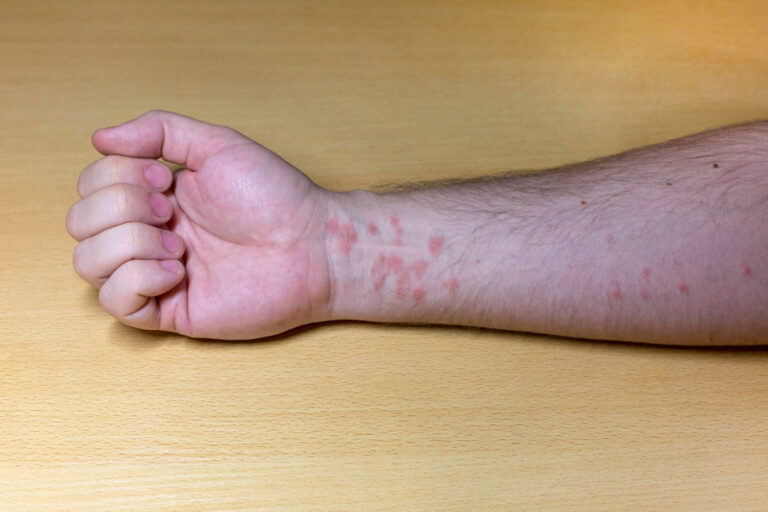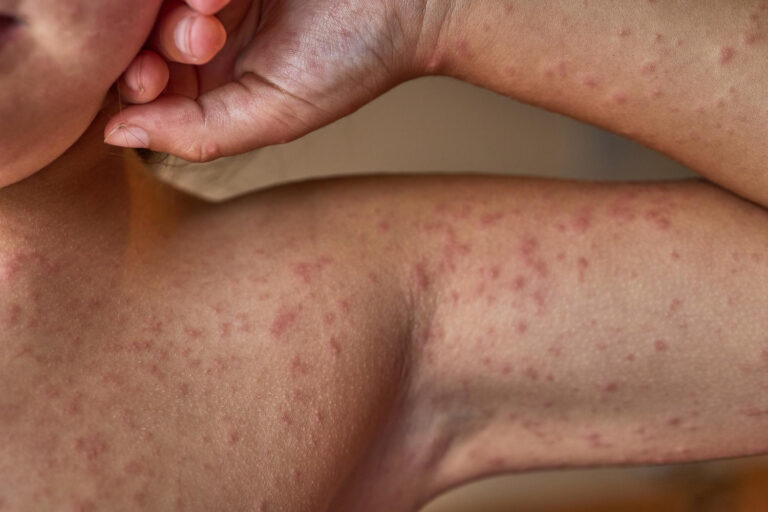
If you’ve ever noticed red, itchy bumps suddenly appearing on your skin, you’ve probably experienced hives. Also known as urticaria, hives can appear suddenly, cause intense itching, and disappear within hours — only to return later. For many adults, hives can be more than a passing nuisance; they can indicate allergic reactions, stress responses, or even underlying medical conditions.
In this detailed guide, we’ll explore what causes hives in adults, their common symptoms, and the most effective treatments to manage and prevent them.
What Are Hives?
Hives are raised, itchy welts that appear on the skin as a reaction to various triggers. They can range in size from tiny dots to large patches and often come and go quickly. The welts are usually red or skin-colored and may appear anywhere on the body — including the face, arms, legs, trunk, or even inside the mouth.
When you have hives, your body releases histamine, a natural chemical involved in the immune response. Histamine causes the tiny blood vessels in your skin to leak fluid, resulting in those swollen, itchy patches.
Hives can last for:
- Acute (short-term) – lasting less than 6 weeks
- Chronic (long-term) – lasting more than 6 weeks or recurring frequently

Common Causes of Hives in Adults
A wide range of factors can trigger hives. In some cases, the cause is apparent (like an allergic reaction), while in others, it’s more complex or unknown. Below are some of the most common causes:
1. Allergic Reactions
Allergies are one of the leading causes of hives. When your immune system reacts to an allergen, it releases histamine, leading to red, itchy welts.
Common allergens include:
- Certain foods (nuts, shellfish, eggs, milk, berries)
- Medications (antibiotics, aspirin, ibuprofen)
- Insect bites or stings
- Latex or pet dander
2. Stress and Emotional Triggers
Emotional stress doesn’t just affect your mind — it can impact your skin too. Stress releases hormones like cortisol and adrenaline, which can trigger or worsen hives in some adults. If you notice flare-ups during times of anxiety or emotional strain, stress might be your culprit.
3. Infections
Both viral and bacterial infections can lead to hives. Common examples include:
- Common cold or flu
- Urinary tract infections (UTIs)
- Hepatitis or mononucleosis
- Dental infections or sinusitis
Your immune system may react to the infection by releasing histamines, resulting in temporary hives.
4. Environmental Factors
External irritants can also cause hives in adults. These include:
- Pollen or mould exposure
- Cold or hot temperatures
- Sunlight (solar urticaria)
- Water (aquagenic urticaria — rare)
- Friction or pressure on the skin (dermatographism)
5. Medications and Medical Treatments
Certain medications or medical procedures can trigger hives, even if you’ve taken them before without a problem.
Examples:
- Antibiotics (penicillin, sulfa drugs)
- Pain relievers (NSAIDs, aspirin)
- Blood pressure medications
- Vaccinations or IV contrast dyes used in scans
6. Autoimmune Disorders
Sometimes, hives can be a symptom of an overactive immune system that mistakenly attacks healthy cells. This can happen in autoimmune diseases like:
- Lupus
- Thyroid disorders (especially Hashimoto’s disease)
- Rheumatoid arthritis
7. Unknown Causes (Idiopathic Urticaria)
In many cases, despite extensive testing, no specific cause is found. This is known as chronic idiopathic urticaria. While frustrating, these cases can still be managed with lifestyle changes and medications.
Recognising the Symptoms of Hives
Hives are typically easy to spot — but they can vary in appearance from person to person.
Here’s what to look out for:
- Raised welts or bumps: Often red or skin-colored and can merge into larger patches.
- Intense itching: The most common and irritating symptom.
- Swelling: Especially around the eyes, lips, hands, or feet (called angioedema).
- Burning or stinging sensation: Particularly with severe or chronic hives.
- Fluctuating pattern: Welts may appear, fade, and reappear in different areas within hours.
Emergency Warning Signs:
Seek medical help immediately if you experience:
- Swelling of the throat or tongue
- Difficulty breathing or swallowing
- Dizziness or fainting
- These could be signs of a severe allergic reaction (anaphylaxis).
How Hives Are Diagnosed
If your hives are frequent, severe, or long-lasting, it’s essential to see a doctor — preferably a dermatologist or allergist.
Your doctor will:
- Review your medical history and recent activities
- Ask about foods, medications, or environmental exposures
- Possibly recommend allergy testing or blood work
- Conduct a skin prick test or an elimination diet if food allergies are suspected.
Identifying the trigger is key to preventing future flare-ups.
Effective Treatment Options for Hives
The good news? Most hives can be treated effectively — often with simple remedies.
Treatment depends on the severity, duration, and cause of your hives.
1. Antihistamines (First-Line Treatment)
Antihistamines block the effects of histamine and are the most common and effective treatment for hives.
Common options include:
- Cetirizine (Zyrtec)
- Loratadine (Claritin)
- Fexofenadine (Allegra)
- Diphenhydramine (Benadryl)
Your doctor may adjust doses or recommend combining non-sedating antihistamines for better control.
2. Corticosteroids
For severe or persistent hives, oral corticosteroids (like prednisone) may be prescribed for short-term relief. These help reduce inflammation but are not meant for long-term use due to side effects.
3. Avoiding Triggers
If you’ve identified your trigger, the best treatment is avoidance.
- Keep a symptom diary to track foods, activities, and stress levels.
- Avoid known allergens or irritants.
- Choose gentle, fragrance-free skincare products.
4. Cool Compresses and Oatmeal Baths
Applying a cold compress or soaking in an oatmeal bath can soothe itching and reduce swelling naturally.
5. Prescription Medications
In cases of chronic hives, your doctor might prescribe:
- Montelukast (Singulair) – a leukotriene receptor blocker
- Omalizumab (Xolair) – an injectable biologic for antihistamine-resistant hives
- Cyclosporine – for autoimmune-related chronic hives
6. Stress Management
Since stress can worsen hives, relaxation techniques can help reduce flare-ups.
Try:
- Deep breathing or meditation
- Regular exercise
- Adequate sleep
- Yoga or mindfulness sessions
Home Remedies for Quick Relief
If you’re dealing with mild hives at home, try these soothing remedies:
- Apply aloe vera gel – reduces redness and itching naturally.
- Use cold packs – helps calm irritation and swelling.
- Wear loose, cotton clothing – it prevents friction on sensitive skin.
- Avoid hot showers – opt for cool or lukewarm water.
- Stay hydrated – helps flush out allergens and toxins.
When to See a Doctor
See a healthcare provider if:
- Your hives persist for more than a few days.
- They recur frequently without an apparent cause.
- You experience swelling of the face or throat.
- Over-the-counter treatments are not working.
A professional evaluation can help uncover hidden triggers and provide long-term management strategies.
Preventing Hives: Tips for Adults
Prevention is always better than a cure. Follow these practical steps to reduce the chances of getting hives again:
- Identify and avoid personal triggers (foods, stress, heat, etc.).
- Use hypoallergenic laundry detergents and skincare products.
- Maintain a healthy immune system through balanced nutrition.
- Manage stress effectively.
- Stay indoors during high pollen days if you have allergies.
Keeping track of your outbreaks can also help your doctor identify patterns and create a personalised treatment plan.
Living with Chronic Hives
Chronic hives can be frustrating, but they’re manageable. With the proper medical guidance and self-care, most people lead normal, comfortable lives.
Many adults find relief by combining medical treatment, trigger avoidance, and stress control. Support groups and counselling can also help if the condition affects your confidence or quality of life.
Conclusion
Hives in adults are common, but understanding their causes, symptoms, and treatments can make all the difference. Whether triggered by allergies, stress, or unknown factors, hives can be effectively controlled with proper diagnosis and care.
If you’re struggling with frequent or severe hives, don’t ignore the symptoms — consult a dermatologist or allergy specialist to identify the cause and find the best treatment for you.
With the right approach, you can keep your skin calm, clear, and comfortable — no matter what triggers come your way.

